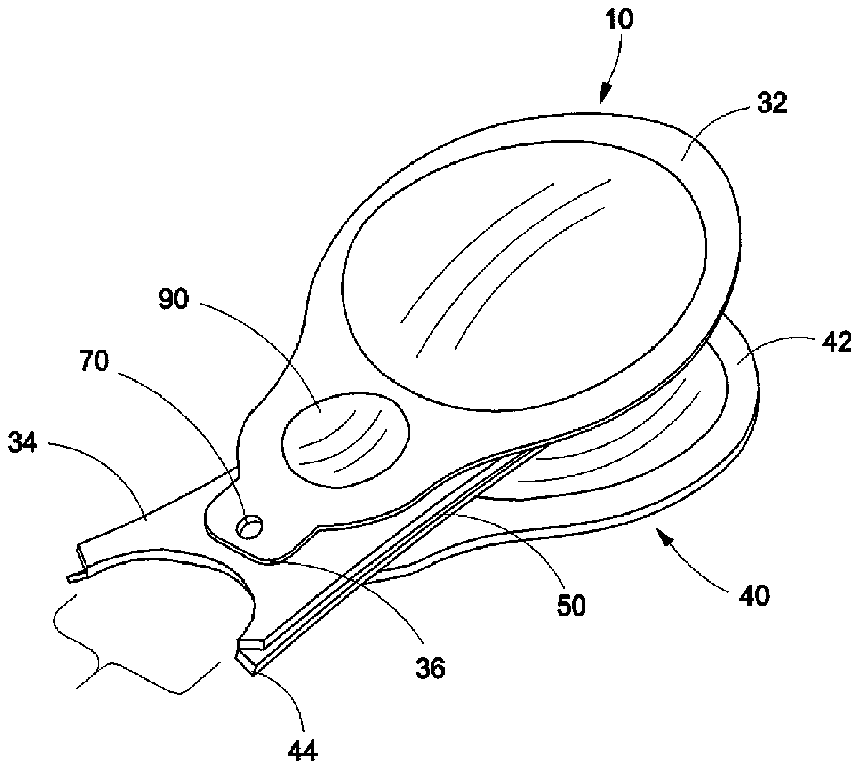
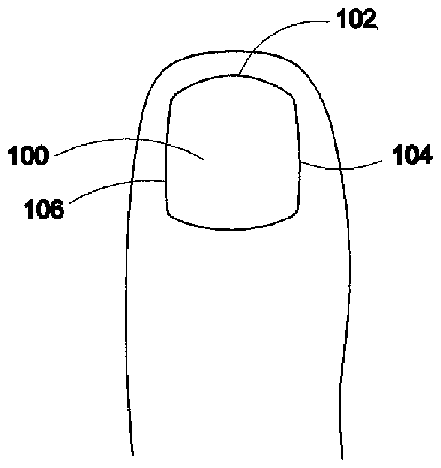
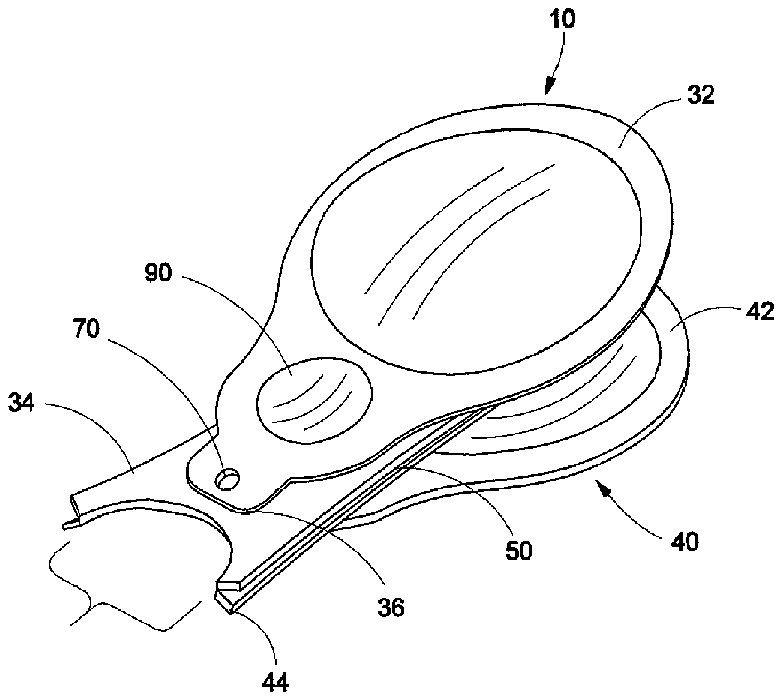
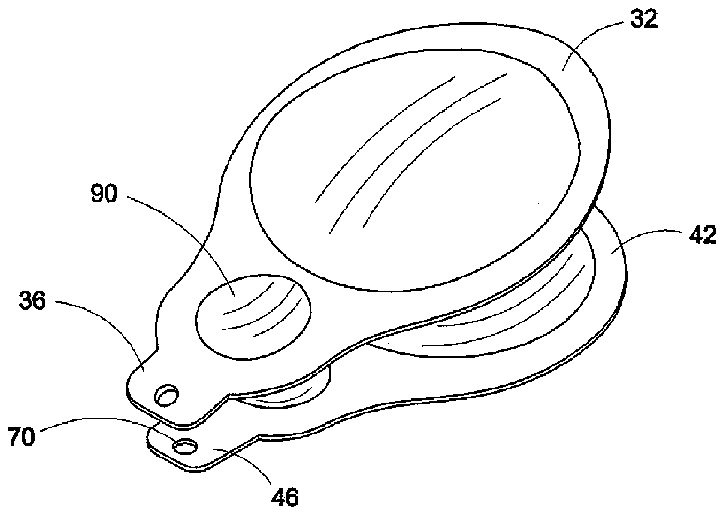
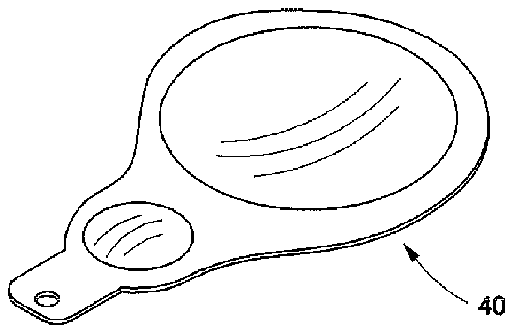

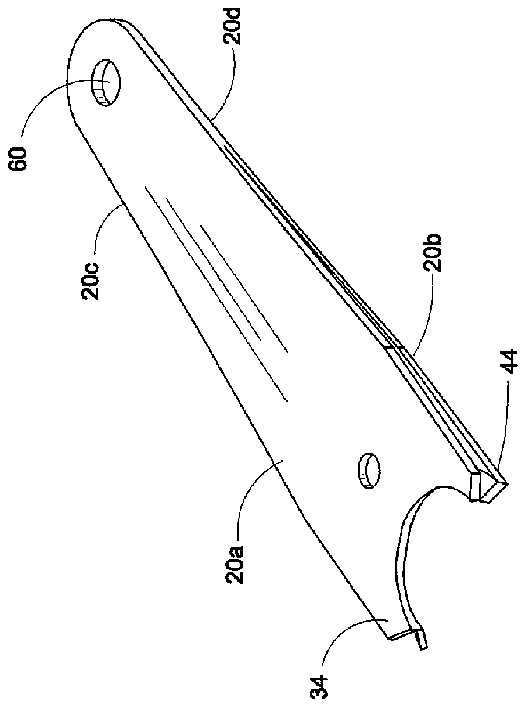
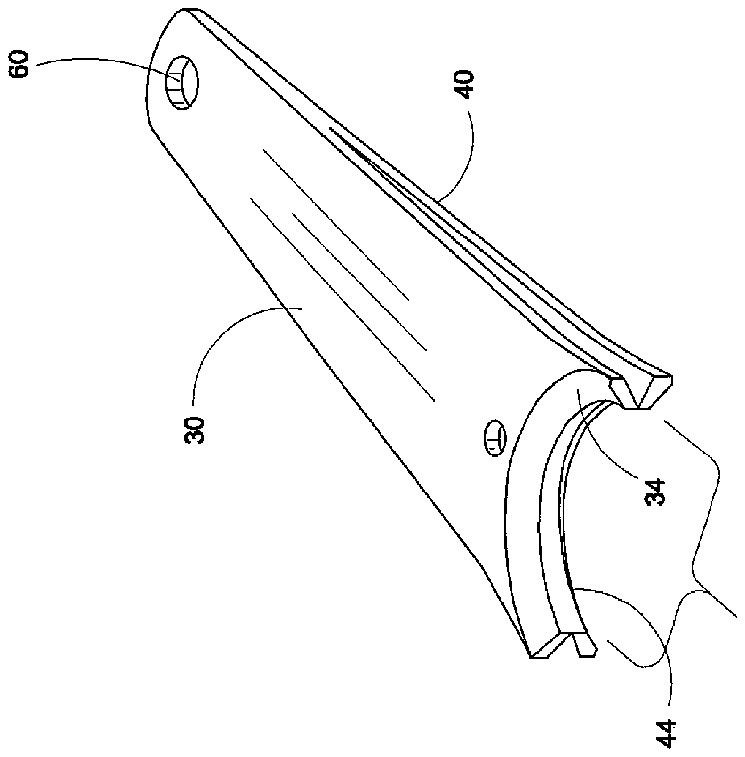
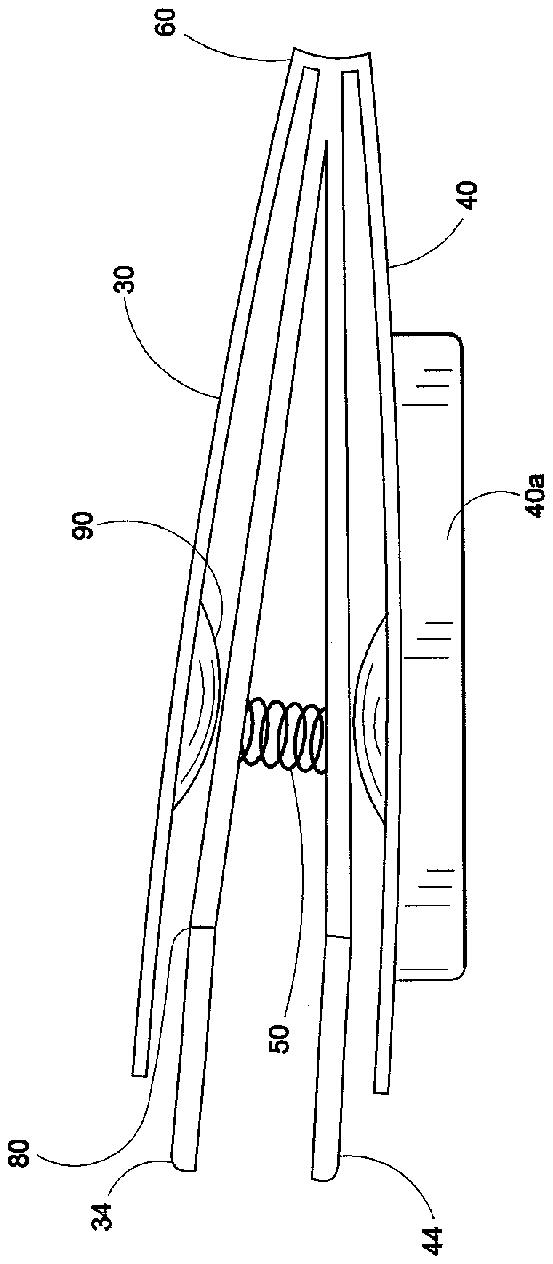
- 10device
- 20blades
- 25shape
- 30first lever
- 32first end
- 34cutting ends
- 36second end
- 40base
- 42first end
- 44cutting end
- 46second end
- 50biasing element
- 60device 10 comprises engagement
- 90stand-off
- 100nail
- 102distal edge
- 104opposing sides
- 110work surface
Abstract
A nail clipping device is disclosed which is designed to increase ease of use for users with diminished capacity, improve uniformity, and increase efficiency of a manicure. The device includes a lever and base each associated with a blade; the blades are biased apart and the device includes at least one stand-off to magnify pressure applied to the lever. The base may be designed to rest on a work surface eliminating the need for a user to squeeze the blades together. A cutting end of each blade comprises a shape; in one embodiment the cutting ends are detachable allowing interchangeability for different shapes.
Description
CROSS-REFERENCE TO RELATED APPLICATION
[0001] This application claims the benefit of U.S. Provisional Application No. 61/993,404 filed with the United States Patent and Trademark Office on May 15, 2014, the entire contents of which is hereby incorporated by reference
FIELD OF INVENTION
[0002] The present invention relates, in general, to manicuring tools and, more specifically to a device for shaping a fingernail or toenail.
BACKGROUND
[0003] For many years, people have been manicuring or having manicured toenails and/or fingernails. The process almost always includes a plurality of steps and iterations comprising, generally, the steps of cutting, shaping and smoothing the nail's edges.
[0004] A nail—toe or finger—comprises a nail plate. The nail plate is attached to the body by the nail matrix located under the cuticle and from which the nail grows and by the nail bed which is located between the finger (or toe) and the nail. The portion of the nail plate near the cuticle is the lunula; the opposite end of the nail plate is called the distal edge. There are two opposing sides of the nail plate running between the lunula and the distal edge. It is the distal edge that is typically cut and shaped during a manicure; the top surface of the nail may be buffed smooth to and thereafter polished.
[0005] In general, the manicure includes several pre-treatment steps to prepare the nail for filing and shaping. Once prepared, the nail is first cut into the rough semblance of the desired finished shape, leaving extra length for filing and shaping. This first cut is a gross cut addressing the distal edge of the nail plate and the two opposing sides. It is typically meant to shorten and give a general shape to the end of the distal edge of the nail. The gross cut advisedly leaves the nail a bit longer than is desired for the finished nail. This extra length allows for shaping via filing through which some length will be lost. The gross cut maybe accomplished using straight scissor-type blades or slightly curved clipper-type blades. When a clipper is used to cut the distal edge it typically leaves relatively abrupt corners on the nail; thereafter, a smaller set of scissors or the clippers may again be used to address the abrupt corners by cutting to blunt the corners and to still further shape the nails. Thereafter, a file is used to create the final desired shape, and to smooth the corners as desired. It requires some skill and experience to obtain a set of 10 highly similarly shaped nails. In addition to the gross cut, and blunting the corners, the nail edges are filed as a finer means to attain the desired length and shape. Often adjustments need to be made in the process in order to achieve general uniformity in nail tip shape, and it is not unusual to lose nail length in doing so. More importantly, as one nail is shaped, the one shaped just prior may need to be adjusted a bit; these adjustments go on as each of the additional nails are filed and shaped which can be quite time consuming. Buffing the nail may follow to smooth the nail's surface and add smoothness to the edge prior to adding nail polish.
[0006] Even those who do not go to the trouble of manicuring or having manicured their nails per se may still regularly trim their nails. For either task, the elderly or any with tendonitis, arthritis, carpal tunnel syndrome or other ailments that affect the strength or coordination of the hands struggle with the devices currently available for trimming or cutting fingernails and toe nails. The struggle is compounded by the need to use the currently available devices several times for each nail in order to accomplish the uniformity that most desire.
[0007] What was needed was a way to accurately shape and cut the nail by using a simple, one step cut. What was also needed was a means to reduce or eliminate filing for the purpose of shaping and thereby save time and increase ease of achieving uniformity of nail shape and length.
SUMMARY OF THE INVENTION
[0008] The present invention comprises a tool for significantly reducing the time and effort needed to shorten and shape the nail whether for a decorative manicure or for a routine trim. The present invention avoids the problems of prior art methods of manicuring.
[0009] Previously known methods and associated equipment employ a slightly curved or straight set of blades and require several different cuts of the same nail in an effort to provide only a semblance of the desired final shape. This general shape is then painstakingly perfected through filing and readjustment of the shape and length. This routine is reiterated for each of the ten digits during which the length and shape of some of the ten nails may be adjusted several times until the set of ten appears uniform in shape and desired length.
[0010] The present invention provides a method to obtain the desired shape, uniformly for each nail, with a single cut for each nail. It also provides a device which is designed to facilitate ease of cutting the nail; the assembly is especially designed for use by those with reduced strength or coordination.
[0011] The present invention employs at least one pre-shaped set of blades 20 , said blades set in a clipping device 10 having a first lever 30 , a base 40 , and a biasing member 50 . The device 10 may be used by placing the base 40 on a surface and then positioning the distal edge 102 of a nail 100 between the preshaped blades 20 a and 20 b . Thereafter, the first lever 30 is pressured resulting in pressing together the blades 20 a and 20 b to cut the distal edge 102 of the nail 100 in precisely the desired shape which reflects the shape 25 of the preshaped blades 20 a and 20 b . The opposing sides 104 , 106 of the nail 100 may be smoothed of any edges thereafter if desired, but shaping the nail 100 is no longer necessary. In one clip, the present invention 10 cuts and shapes the nail 100 thereby avoiding the multiple cuts, and the extensive filing that may otherwise be necessary to result in nails of uniform shape and length.
BRIEF DESCRIPTION OF THE DRAWINGS
[0012] FIG. 1 is a schematic diagram of a finger and fingernail;
[0013] FIG. 2 is a perspective view of a first embodiment of the present invention;
[0014] FIG. 3 is a perspective view showing the details of lever 30 and base 40 ;
[0015] FIG. 4 is a top view of the base 40
[0016] FIG. 5 is a perspective view of the blades 20 a and 20 b;
[0017] FIG. 6 is a close-up view showing the arrangement of blades 20 a and 20 b and biasing element 50 ;
[0018] FIG. 7 is another view of the blades 20 a and 20 b;
[0019] FIG. 8 is a side view of a second embodiment of the present invention.
DETAILED DESCRIPTION
[0020] The present invention provides a device 10 to shape a nail 100 and a method of using the device 10 to achieve a uniform manicure in less time than prior manicuring methods. In one embodiment, the device 10 includes a pair of blades 20 a and 20 b , a first lever 30 and a base 40 which are separated by a biasing element 50 biasing a first end 32 of the first lever 30 and a first end 42 of the base 40 apart. The biasing element 50 may comprise a metal or plastic spring or springs, a tab or strut-like element made of resilient and compressible material, a resilient biasing member. One of ordinary skill in the art would understand there are many ways to provide resilient bias between two elements which are associated at one end in a spaced apart manner. The blades 20 a and 20 b each comprise a cutting end, 34 and 44 . The cutting ends further comprise a shape 25 . The device 10 may comprise integration of a second end 36 of the first lever 30 which may be associated with the blade 20 a near its cutting end 34 for example, at 70 . The second end 46 of the base 40 may be associated with the lower blade 20 b near its cutting end 44 . In another embodiment, the lower blade 20 b may be an integrally formed part of the base 40 or the lower blade 20 b may be formed to also serve as the base 40 .
[0021] One embodiment of the device 10 comprises engagement 60 of a non-cutting end 20 c and 20 d of each of the blades 20 a and 20 b to each other, with the biasing element 50 positioned oppositely near the cutting ends 34 and 44 . The first lever 30 is associated with blade 20 a near the cutting end 34 ; the base 40 is associated with blade 20 b near its cutting end 44 . Alternatively, the device 10 may comprise means to detachably associate 80 the cutting ends 34 and 44 and the blades 20 a and 20 b . This detachable association 80 may comprise a snap-lock, biasing device, pin, friction fit, or the like. This embodiment would allow the device to employ interchangeable cutting end pairs, having different shapes for cutting the nails.
[0022] In one embodiment the first lever 30 comprises a depression or stand-off 90 which extends toward the blade 20 a ; when pressure is applied to the first lever 30 the stand-off leverages that pressure to the blade 20 a to close its cutting end 34 against cutting end 44 . In some embodiments the base 40 may include a similar stand-off 90 on the base 40 for better positioning of the blade 20 b and cutting end 44 relative to blade 20 a . The embodiments comprising blade 20 b integrated with base 40 or serving as base 40 may provide means for operation that does not require the user to squeeze the first lever 30 and the base 40 together while holding the device but, instead, allows for operation by placing the base 40 on a surface and pressuring the first lever 30 toward the base to cut the nail 100 .
[0023] In some embodiments the base 40 may be formed substantially the same as the first lever 30 and may or may not include a stand off. This embodiment would be more amenable to the user holding the assembly 10 in one hand between fingers and thumb and squeezing the lever 30 and the base 40 together to cut the nail 100 . However, an appropriately shaped base 40 could allow operation either by squeezing lever 30 and base 40 together, or by pressuring the lever 30 while base 40 rests against a work surface 110 .
[0024] The method of using the device requires selecting a pair of generally identically shaped cutting ends 34 , 44 of the appropriate and desired shape 25 and attaching them to blades 20 a and 20 b ; alternatively, one may select a device 10 that includes cutting ends 34 , 44 permanently affixed to blades 20 a and 20 b . The upper cutting end 34 associated with lever 30 is then positioned above the first finger's nail's distal edge 102 , the lower cutting end 44 below, with the center of the blades' shape generally over the center of the nail's distal edge; the base 40 and the lower cutting end 44 may be generally horizontally aligned although such alignment is not required. In one embodiment, a horizontally parallel alignment is achieved by using a base 40 shaped to provide a spaced apart relationship between the lower cutting end 44 and a work surface 110 on which the base 40 rests, thereby allowing the finger to rest on the work plane 110 and the nail's distal edge 102 to easily slide between the cutting ends 34 and 44 . Other arrangements may be employed to allow the finger to rest appropriately below the lower cutting end, including providing a finger rest associated with the device, or a slightly raised platform 40 a upon which the cutting ends and blades are mounted. Once positioned, the base 40 of the device 10 rests on work surface 110 . The first lever 30 is depressed and the cutting ends 34 and 44 cut the nail in the shape 25 of the cutting ends 34 and 44 . The shape 25 may be oval, square, round, oblong, etc. Each cut is substantially identical in shape and clean. Minimal smoothing of the cut edge is all that is required. Each nail can, in its turn, be inserted between the cutting ends and using the free hand or other means of applying pressure, the first lever 30 is easily pressed downward (more particularly minimized in embodiments comprising the stand-off) toward the work surface 110 and the base 40 to simply effect the nail's cut without two-handed operation, and with minimal pressure.
[0025] One advantage of the present invention is to facilitate minimal cut strokes to assist those with arthritis or other painful maladies of the joints or wrist that may be bothered by squeezing.
[0026] A second advantage of the present invention is to provide a simpler method to achieve a good manicure without the assistance of another person.
[0027] A third advantage is to avoid multiple cuts and to minimize or eliminate the time consuming task of adjusting the shape of each of the nails relative to the others to achieve uniformity in shape and length.
[0028] The present invention has been described with particularity, however, it should be understood that the shape of the blade pair may take on any of many. Further, while it is important that one blade be associated with the lever, and another blade be associated with the base (or another element highly similar to the lever) in order to provide the simplest use, the exact means and arrangement of that association is not particularly important so long as it addresses the need to provide means to cut a fingernail that requires less hand strength or coordination. One embodiment describes one or two stand-offs or depressions positioned against either or both blades in a manner to create means for closing the cutting blades using less movement of the lever, and/or less pressure to do so. The simplicity of cutting a nail by simply pressing on the lever while the base is supported by a table or counter-top is inventive. Further, providing pre-shaped blade reduces the efforts required to obtain a uniform nail set. Detachable/replaceable blades further extend the usefulness of the assembly by allowing its use to attain different nail shapes as desired. Other relationships that allow for such ease of use are also contemplated by the invention.
